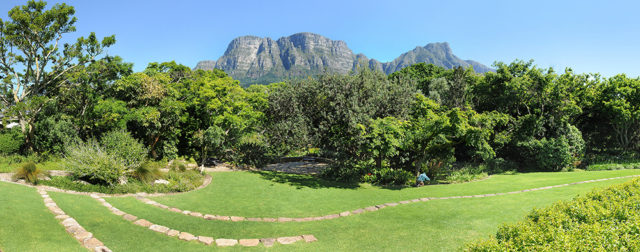The Vineyard gardens have delighted and fascinated for over 200 years, and in 2016 they remain as innovative and ground breaking as they were when they were first created.
Its beautiful lush paths and by-ways that stretch across 7.5 acres of plush suburbia, its proximity to Table Mountain and the banks of the Liesbeek River, and its large number of interesting flora and fauna all come together to ensure that enthusiasts travel from far and wide in order to experience it for themselves.
Origin of the Vineyard gardens
These famous grounds were originally home to diarist and artist Lady Anne Barnard and husband Andrew, colonial secretary to the Governor of the Cape of Good Hope, Earl Macartney. The Barnard’s built their house in February 1800 and it was ground breaking from the start, being the first ‘English’ style house in the Cape. The gardens flourished, full of indigenous shrubs like protea and keurboom, as well as box and fir. Lady Anne’s own watercolours are remaining proof of this – one she sketched from the stoep refers to her garden as, “growing, growing, growing!”
Out beyond the garden were the original vineyards that stretched in all directions, giving the house its name.
Lady Anne Barnard was a dynamic, progressive woman, full of interesting ideas and as such, way ahead of her time. This spirit has remained so much a part of the property, translating into the way this extraordinary garden has developed and adapted over the centuries.
The vines at the Vineyard
Time and ‘progress’ took its toll on the vines however, but in 2008 current owners, the Petousis family, celebrated the 350th anniversary of winemaking in the Cape by replanting the vineyard.
“The intention is never for this to be a commercial project,” says Roy Davies, General Manager. “Yes, we harvest the vines – and our five wine partners (Meerlust, Klein Constantia, Simonsig, Warwick and Waterford) take turns annually to produce wine from our grapes, but the main idea has always been to keep the Vineyard’s history alive for our guests. Not only can they visit our genuine vineyard planted with a range of grape varieties, but we use it to enliven our wine offering”.
In February 2016 our block was harvested of its exceptionally healthy looking grapes. This is the fourth successful harvest of the new vines and everyone at the hotel is excited to sample the results.
Greening and sustainability
But it’s not just beautiful garden paths and elegant beds. There is a huge focus on sustainability and utilising the Vineyard gardens to lower their carbon footprint. With this aim, a prolific herb garden flourishes on the property behind the spa area, and is utilised in the kitchens on a daily basis.
Resident environmentalist and horticulturalist Bruce Nutman has been monitoring its output since November 2015 and is able to say with confidence that although it’s not big enough to keep up with the demand from the busy kitchen, it supplements the required amount perfectly. “I am constantly ordering and planting new seedlings of many different herbs and veggies to keep up a supply for the kitchen,” says Nutman. “Our herbs and other plants are looking good and are harvested daily.”
Recently, a number of Heirloom Seedlings, which is the name given to open pollinated seeds that have been handed down through generations, were planted out. These consisted of various radishes, cherry tomatoes and micro-greens. An unusual heatwave and an overly-enthusiastic tortoise – who managed to push his way through the protective barrier – put paid to plans for these particular seedlings, but Nutman and the gardening team are not dissuaded. “A percentage of these were lost, but we will be re-planting in the new season and hope for a successful transition from garden to plate”.
The Vineyard tortoises
Talking of the tortoises, these popular residents may be well over fifty years old but are in fine fettle, with Nutman noting that the females have just laid eggs in various areas of the grounds.
Although the Vineyard gardens remains stoutly true to its past, it is constantly evolving to keep up with the times, and is lauded as one of the most environmentally-friendly, progressive properties in the area.

